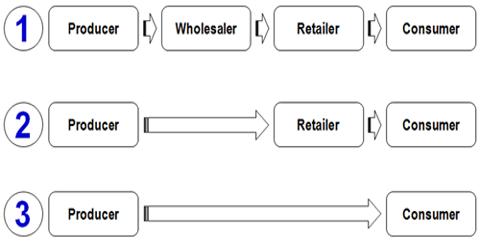Indirect Channels
When a manufacturer employs one or more intermediary to move goods from the point of production to the point of consumption, the distribution network is called indirect. There is no direct contact between the producers and the customers.
The causes for indirect channels of distribution are:
- Better control on the supply of goods.
- Speedy disposal of products.
- Lesser expenses on selling.
- Better training of sales people and
- Rapid feedback.
This may take any of the following forms:
Manufacturer-Retailer Consumer (One Level Channel): In this channel, the manufacturer sells goods to consumer through retailers. This channel of distribution thus has one middleman i.e. the retailer. That is, goods pass from the manufacture to the retailers who, in turn, sell them to the final users.
For example, Consumer durables such as TVs, refrigerators, scooters, washing machines, cars and industrial machinery and equipment are generally sold through this channel.
Manufacturer-Wholesaler-Retailer-Consumer (Two Level Channel): This channel consists of two types of middlemen, called, wholesaler and retailer. Consumer products of daily use such as soaps, cosmetics, detergents, etc. are generally sold through this channel. Here the wholesaler and retailer function as connecting links between the manufacturer and consumer. Use of two middlemen in the channel network enables the manufacturer to cover a larger market area.
Example: UniLever Ltd., sells its products through wholesalers and retailers.
Manufacturer-Agent-Wholesaler- Retailer-Consumer (Three Level Channel): In this case, manufactures use their own selling agents or brokers who connect them with wholesalers and then the retailers. This is the largest channel of distribution. The producer sells his total output to a sole selling agent who in turn appoints wholesalers. Wholesalers sell to retailers who in turn sell to final customers. This channel is admired in the distribution of cloth, food grains, sugar, edible oil, paper, etc.















